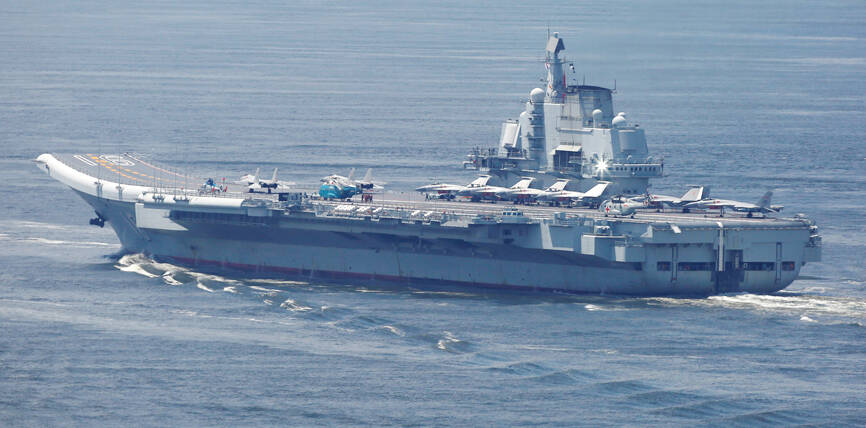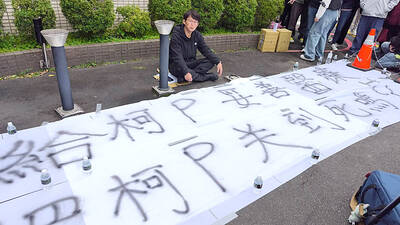China is increasingly likely to employ a strategy of anti-access/area denial (A2/AD) around Taiwan, which would use three carrier groups, a report from the Mainland Affairs Council (MAC) said.
When China’s third aircraft carrier, the Fujian, is completed next year, China would have three carriers, which would likely be used to surround Taiwan and implement an A2/AD strategy, it said, adding that efforts to strengthen China’s two other carriers — the Liaoning and the Shandong — appear to corroborate this.
In the quarterly report, the council cited declassified documents from the Ministry of National Defense that categorized China’s carriers as a threat if used for A2/AD, and said that China might coordinate its naval, air force and rocket force capabilities to operate beyond the first island chain and deter foreign forces from getting involved in a conflict involving Taiwan.

Photo: Reuters
The Chinese People’s Liberation Army (PLA) Rocket Force would deploy medium and long-range conventional ground-attack and anti-ship ballistic missiles, and cruise missiles to foreign forces in the area between the first and second island chains, it said.
Citing military researchers, the report said that in the event of an attempted invasion of Taiwan, Chinese forces would likely first take formation in the northern part of the Philippine Sea, somewhere between 300km and 800km east of Taiwan proper. This posture would allow China to face Taiwan simultaneously on two fronts, with forces east of Taiwan also acting as a deterrent to foreign forces, it said.
Separately, Institute for National Defense and Security Research fellow Su Tzu-yun (蘇紫雲) on Sunday said that China’s three carriers are part of China’s transition from a land power to a sea power.
The introduction of the Fujian into service would help make the PLA Navy a “blue water navy,” and allow China to more effectively encircle Taiwan, he said.
The range of Taiwan’s Xiangfeng missiles is 200km to 250km, so China’s carriers would be deployed 300km or more east of Taiwan, putting them out of range, he said. Meanwhile, the range of the fighter jets that would be deployed from the carriers is about 800km, so an attack on Taiwan could be launched from within a safe range.
Taiwan can use anti-ship missiles to attack approaching enemy ships, but must rely on submarines to deal with long-distance aircraft, he said, adding that domestically-built submarines are important.
In the event of a war, it would be difficult for Chinese aircraft to safely pass through the Bashi Strait or Miyako Strait, he said, adding that if the US were to help Taiwan, China’s aircraft carriers in waters east of Taiwan would be “sandwiched” between attacks from both sides.
Within the strategic triangle comprised of Hawaii, Guam and Taiwan, Chinese carriers would become the target of the US military, he said.
“Thoughts to the contrary are simply wishful thinking on the part of the Chinese,” he said.
Chinese aircraft carriers stationed east of Taiwan during an attack would also be subject to a war of attrition since they would need supplies within one to two weeks, he said.
“Since the passage of supply ships through the Bashi Channel or Miyako Strait would be too dangerous, and China has no overseas bases, supplying the carriers would be impossible,” he said. “Any advantage brought by the carriers would be quickly lost.”

‘DENIAL DEFENSE’: The US would increase its military presence with uncrewed ships, and submarines, while boosting defense in the Indo-Pacific, a Pete Hegseth memo said The US is reorienting its military strategy to focus primarily on deterring a potential Chinese invasion of Taiwan, a memo signed by US Secretary of Defense Pete Hegseth showed. The memo also called on Taiwan to increase its defense spending. The document, known as the “Interim National Defense Strategic Guidance,” was distributed this month and detailed the national defense plans of US President Donald Trump’s administration, an article in the Washington Post said on Saturday. It outlines how the US can prepare for a potential war with China and defend itself from threats in the “near abroad,” including Greenland and the Panama

The Chinese Nationalist Party (KMT) is maintaining close ties with Beijing, the Democratic Progressive Party (DPP) said yesterday, hours after a new round of Chinese military drills in the Taiwan Strait began. Political parties in a democracy have a responsibility to be loyal to the nation and defend its sovereignty, DPP spokesman Justin Wu (吳崢) told a news conference in Taipei. His comments came hours after Beijing announced via Chinese state media that the Chinese People’s Liberation Army’s Eastern Theater Command was holding large-scale drills simulating a multi-pronged attack on Taiwan. Contrary to the KMT’s claims that it is staunchly anti-communist, KMT Deputy

RESPONSE: The government would investigate incidents of Taiwanese entertainers in China promoting CCP propaganda online in contravention of the law, the source said Taiwanese entertainers living in China who are found to have contravened cross-strait regulations or collaborated with the Chinese Communist Party (CCP) could be subject to fines, a source said on Sunday. Several Taiwanese entertainers have posted on the social media platform Sina Weibo saying that Taiwan “must be returned” to China, and sharing news articles from Chinese state media. In response, the Mainland Affairs Council (MAC) has asked the Ministry of Culture to investigate whether the entertainers had contravened any laws, and asked for them to be questioned upon their return to Taiwan, an official familiar with the matter said. To curb repeated

Taiwan People’s Party (TPP) Chairman Huang Kuo-chang (黃國昌) yesterday appealed to the authorities to release former Taipei mayor Ko Wen-je (柯文哲) from pretrial detention amid conflicting reports about his health. The TPP at a news conference on Thursday said that Ko should be released to a hospital for treatment, adding that he has blood in his urine and had spells of pain and nausea followed by vomiting over the past three months. Hsieh Yen-yau (謝炎堯), a retired professor of internal medicine and Ko’s former teacher, said that Ko’s symptoms aligned with gallstones, kidney inflammation and potentially dangerous heart conditions. Ko, charged with